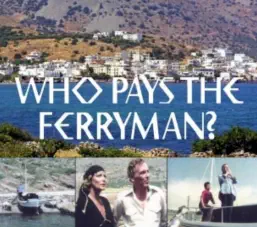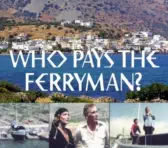Several T.V. Series have been filmed around Eastern Crete with locations in Neapoli, Agios Nikolaos, Plaka, Spinalonga and Elounda.
The Island (2010-2011) – 26 episodes
The novel was written by Victoria Hislop, who is passionate about Greece, has a house in Eastern Crete and was granted Greek
citizenship in 2020 for her contribution to the promotion of Greece’s history and traditions through her books. The book and T.V.
series tell the story of a young woman, Alexis, trying to find out about her mother’s past. It is a tale of illicit love, violence and leprosy,
encompassing four generations from the thirties to the present day. It was filmed around Plaka and Spinalonga, the one time leper
colony, which closed in 1957. The series was made for MEGATV and Victoria was very involved in the filming, helping with editing the
script, adapting the storyline and even sewing costumes. She had a small part playing a patient, who is suffering from leprosy. Her
husband, Ian Hislop, a British journalist, satirist, writer, broadcaster, and editor of the magazine Private Eye, also appears as Alexis’
father, Marcus Fielding, the only English character, (although Ian speaks his dialogue in Greek).
Cartes Postales (2021) – 12 episodes
This is another adaptation of a Victoria Hislop novel, but this time it is set in the present day. The series is made up of 12 episodes,
each telling a different story and shot on location on the magical island of Crete. It was broadcast on the Greek channel ERT1 and is in
Greek, starring Andreas Konstantinou. Ellie receives a postcard every week. They are signed by ‘A’ and addressed to someone she
does not know. They show beautiful images of Greece, with its azure skies and blue seas and allow Ellie to escape from her life. She
creates a collage of them on the wall of her little flat and looking at them every day decides that she must see Greece for herself.
After six months, the postcards no longer arrive and this spurs her on to fly to Athens. On the morning of her departure, a parcel
arrives – a notebook written by ‘A’. She begins to read the story of his journey through Crete.
Shot in 80 different locations in Crete and London, it is a homage to the beautiful island of Crete’s beauty, customs and traditions. It
showcased the idyllic beaches of Elounda, the beautiful landscape of Lassithi, fabulous gorges and caves, olive groves and vineyards,
the city of Heraklion, village tavernas and seaside resorts. “……undoubtedly a really positive development for the Region of Crete. We
firmly believe that this production showcases beautifully the unique and distinctive characteristics of our island ….. We extend our
warmest congratulations to the Director, and everyone involved in this TV series for producing such great results’’ said Stavros
Arnaoutakis, Governor of the Region of Crete.
Victoria Hislop is also quoted as saying, “Being in Crete is always special for me, and filming Cartes Postales was an exceptional
privilege. The landscapes and the people of Crete made this a truly wonderful experience and the results on the screen will bring the
magic of this island to an even wider audience. I hope everyone who watches the TV series will come to Crete to see the place for
themselves!”
Who Pays the Ferryman? (1977) – 8 episodes
This television series was produced by the BBC and written by Michael J. Bird. The series is based in Crete and incorporates local
history and folklore. The stunning scenery of Crete helped the series to become a huge success. It was filmed in and around Elounda
and the locations included Neapoli (episode 6: The Well). Anthony Papaleontiou has spent time investigating the locations of all eight
episodes and has created a very interesting website, www.whopaystheferryman, which tells a story and uses photos, YouTube videos
and Google maps as evidence. The theme tune, composed by Yannis Markopoulos, reached the UK singles chart in late 1977 and
early 1978. The title of the series refers to Greek Mythology and the story of Charon, the ferryman to Hades. In ancient times, it was
the custom to place coins in or on the mouth of the dead before cremation so that the deceased could pay the ferryman to go to
Hades. The series starred Jack Hedley. He is a widower and when his boat building business is bought out he decides to return to
Crete. He is an ex-soldier and thirty years ago he had fought alongside the Cretan resistance (andartes) during World War II. Ghosts
from the past are waiting and a present day Greek tragedy is played out. Episode 6 “The Well” was filmed in Neapoli and is available
on You Tube (we couldn’t embed the video here as it was protected) many of the local people we showed it to didn’t even know it had
been filmed here and were very amused to see the old cars, buses and of course the Town itself.
The Lotus Eaters (1972 – 1973) – 15 episodes
This is another series written by Michael J. Bird for the BBC. The series was filmed on location in Crete in Agios Nikolaos. Again, the
title relates to Greek Mythology, where those who ate from the lotus tree lost their desire to return home. The term “lotus eater” also
denotes a person who spends his or her time in pleasure and luxury rather than dealing with practical concerns. It starred the late
Ian Hendry and Wanda Ventham, Erik and Ann Shepherd, who ran a taverna called Shepherds’ Bar. She is a sleeper agent for British
Intelligence, who was forced to marry Erik, a broken down drunk, as part of her cover story. The series theme tune is "Ta Trena Pou
Fyghan" (Τα Τραίνα Που Φύγαν" from the album Hellespont, composed by Stavros Xarchakos.
T.V. Series filmed on Crete
.webp)

2.webp)
1.webp)
1.webp)
Several T.V. Series have been filmed around Eastern Crete with
locations in Neapoli, Agios Nikolaos, Plaka, Spinalonga and
Elounda.
The Island (2010-2011) – 26 episodes
The novel was written by Victoria Hislop, who is passionate
about Greece, has a house in Eastern Crete and was granted
Greek citizenship in 2020 for her contribution to the promotion
of Greece’s history and traditions through her books. The book
and T.V. series tell the story of a young woman, Alexis, trying to
find out about her mother’s past. It is a tale of illicit love,
violence and leprosy, encompassing four generations from the
thirties to the present day. It was filmed around Plaka and
Spinalonga, the one time leper colony, which closed in 1957.
The series was made for MEGATV and Victoria was very
involved in the filming, helping with editing the script, adapting
the storyline and even sewing costumes. She had a small part
playing a patient, who is suffering from leprosy. Her husband,
Ian Hislop, a British journalist, satirist, writer, broadcaster, and
editor of the magazine Private Eye, also appears as Alexis’
father, Marcus Fielding, the only English character, (although
Ian speaks his dialogue in Greek).
Cartes Postales (2021) – 12 episodes
This is another adaptation of a Victoria Hislop novel, but this
time it is set in the present day. The series is made up of 12
episodes, each telling a different story and shot on location on
the magical island of Crete. It was broadcast on the Greek
channel ERT1 and is in Greek, starring Andreas Konstantinou.
Ellie receives a postcard every week. They are signed by ‘A’ and
addressed to someone she does not know. They show
beautiful images of Greece, with its azure skies and blue seas
and allow Ellie to escape from her life. She creates a collage of
them on the wall of her little flat and looking at them every day
decides that she must see Greece for herself. After six months,
the postcards no longer arrive and this spurs her on to fly to
Athens. On the morning of her departure, a parcel arrives – a
notebook written by ‘A’. She begins to read the story of his
journey through Crete.
Shot in 80 different locations in Crete and London, it is a
homage to the beautiful island of Crete’s beauty, customs and
traditions. It showcased the idyllic beaches of Elounda, the
beautiful landscape of Lassithi, fabulous gorges and caves,
olive groves and vineyards, the city of Heraklion, village
tavernas and seaside resorts. “……undoubtedly a really positive
development for the Region of Crete. We firmly believe that
this production showcases beautifully the unique and
distinctive characteristics of our island ….. We extend our
warmest congratulations to the Director, and everyone
involved in this TV series for producing such great results’’ said
Stavros Arnaoutakis, Governor of the Region of Crete.
Victoria Hislop is also quoted as saying, “Being in Crete is
always special for me, and filming Cartes Postales was an
exceptional privilege. The landscapes and the people of Crete
made this a truly wonderful experience and the results on the
screen will bring the magic of this island to an even wider
audience. I hope everyone who watches the TV series will come
to Crete to see the place for themselves!”
Who Pays the Ferryman? (1977) – 8 episodes
This television series was produced by the BBC and written by
Michael J. Bird. The series is based in Crete and incorporates
local history and folklore. The stunning scenery of Crete
helped the series to become a huge success. It was filmed in
and around Elounda and the locations included Neapoli
(episode 6: The Well). Anthony Papaleontiou has spent time
investigating the locations of all eight episodes and has created
a very interesting website, www.whopaystheferryman, which
tells a story and uses photos, YouTube videos and Google
maps as evidence. The theme tune, composed by Yannis
Markopoulos, reached the UK singles chart in late 1977 and
early 1978. The title of the series refers to Greek Mythology
and the story of Charon, the ferryman to Hades. In ancient
times, it was the custom to place coins in or on the mouth of
the dead before cremation so that the deceased could pay the
ferryman to go to Hades. The series starred Jack Hedley. He is
a widower and when his boat building business is bought out
he decides to return to Crete. He is an ex-soldier and thirty
years ago he had fought alongside the Cretan resistance
(andartes) during World War II. Ghosts from the past are
waiting and a present day Greek tragedy is played out.
The Lotus Eaters (1972 – 1973) – 15 episodes
This is another series written by Michael J. Bird for the BBC.
The series was filmed on location in Crete in Agios Nikolaos.
Again, the title relates to Greek Mythology, where those who
ate from the lotus tree lost their desire to return home. The
term “lotus eater” also denotes a person who spends his or her
time in pleasure and luxury rather than dealing with practical
concerns. It starred the late Ian Hendry and Wanda Ventham,
Erik and Ann Shepherd, who ran a taverna called Shepherds’
Bar. She is a sleeper agent for British Intelligence, who was
forced to marry Erik, a broken down drunk, as part of her cover
story. The series theme tune is "Ta Trena Pou Fyghan" (Τα
Τραίνα Που Φύγαν", from the album Hellespont, composed
by Stavros Xarchakos.
T.V. Series filmed on Crete
-1.webp)

2-1.webp)
1-1.webp)
1-1.webp)

